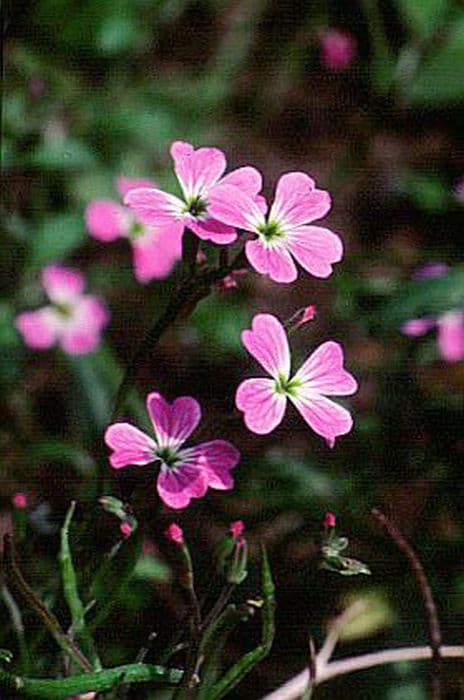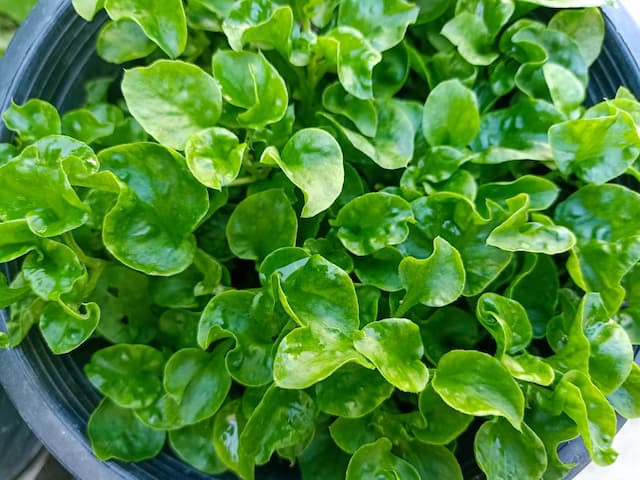Dame's Rocket Hesperis matronalis

ABOUT
Hesperis matronalis, commonly known as dame's rocket, is a flowering plant with an attractive appearance that has made it popular in gardens. The plant features a basal rosette of leaves from which upright stems emerge. These stems are adorned with lance-shaped leaves that are toothed along the edges. The leaves further up on the stems are alternately arranged and become smaller as they ascend the stem. The dame's rocket is well-known for its showy flower clusters that come in shades of white, pink, purple, and sometimes violet. Each flower consists of four cross-shaped petals, forming a simple yet charming floral display. The blossoms typically have a delightful fragrance, especially noticeable in the evening. After flowering, the plant produces elongated seed pods that split open when mature, dispersing the seeds inside. The overall visual appeal of dame's rocket is enhanced by its lush foliage and the clustered effect of its blooms, which can add a wildflower-like charm to any planting area where it is present.
About this plant
 Names
NamesFamily
Brassicaceae.
Synonyms
Dame's Rocket, Dame's Violet, Mother-of-the-Evening, Sweet Rocket.
Common names
Cheiranthus matronalis, Hesperis albiflora, Hesperis inodora, Hesperis matronalis var. candida, Hesperis matronalis var. purpurea, Hesperis matronalis var. albiflora, Hesperis vespertina.
 Toxicity
ToxicityTo humans
Dame's rocket is generally not considered highly toxic to humans. However, like many plants, it may cause mild gastrointestinal upset if ingested in large quantities. This could include symptoms such as nausea, vomiting, or diarrhea. Always exercise caution and avoid eating plants that are not known to be safe for consumption.
To pets
Dame's rocket is not typically listed among plants that are highly toxic to pets, but it can cause mild digestive upset in some animals if ingested. Symptoms could include vomiting or diarrhea and are usually not severe. Nonetheless, pet owners should prevent pets from consuming this or any other plant not specifically intended for them to avoid potential negative effects.
 Characteristics
CharacteristicsLife cycle
Biennials
Foliage type
Deciduous
Color of leaves
Green
Flower color
Varies
Height
2-3 feet (0.6-0.9 meters)
Spread
1-2 feet (0.3-0.6 meters)
Plant type
Herb
Hardiness zones
4-9
Native area
Europe
Benefits
 General Benefits
General Benefits- Aesthetic Appeal: Dame's Rocket adds color to gardens and landscapes with its vibrant purple, pink, or white flowers.
- Attracts Pollinators: Its blossoms are known to attract bees, butterflies, and other beneficial insects.
- Easy Cultivation: Dame's Rocket is easy to grow and requires minimal maintenance, making it suitable for novice gardeners.
- Adaptable Growth: It can thrive in a variety of soil types and environmental conditions.
- Night Fragrance: The flowers emit a pleasant fragrance in the evening, adding a sensory aspect to gardens.
- Erosion Control: It can help stabilize soil and prevent erosion due to its fast-growing habit.
- Seasonal Interest: Dame's Rocket has a lengthy blooming period, from late spring to early summer, providing long-lasting visual interest.
- Food Source for Wildlife: The seeds can serve as a food source for birds and other wildlife.
- Historical Significance: Dame's Rocket has been cultivated for centuries, contributing to heritage gardens and traditional landscaping designs.
- Cutting Garden Plant: The flowers are suitable for cutting and arranging in bouquets, adding diversity to cut flower selections.
 Medical Properties
Medical Properties- Expectorant: Hesperis matronalis, commonly known as Dame's rocket, is traditionally used as an expectorant to help clear mucus from the respiratory tract.
- Diuretic: It is believed to have diuretic properties, which means it can help promote the production of urine and support kidney function.
- Vitamin C source: The plant is known to contain Vitamin C, which is essential for a healthy immune system.
- Sedative: There is some historical reference to its use as a mild sedative to help with sleep disturbances or anxiety.
 Air-purifying Qualities
Air-purifying QualitiesThis plant is not specifically known for air purifying qualities.
 Other Uses
Other Uses- Dame's Rocket can be used as a natural dye, where different parts of the plant may yield different colors for wool and other fabrics.
- In some areas, Dame's Rocket flowers are candied or used as decorative edible accents in salads for their mild sweetness and vibrant colors.
- The plant can also be used as a source of nectar for homemade syrups, imparting a subtle flavor similar to its fragrance.
- Dame's Rocket is suitable for companion planting, attracting beneficial insects that prey on common garden pests.
- The flowers can be steeped in water to create a fragrant floral bath, often used for its soothing properties and aroma.
- Leaves of the Dame's Rocket can be fermented and then used as a green manure to enrich soil in gardens.
- Dried Dame's Rocket petals can be incorporated into potpourri mixtures, adding fragrance and color to the blend.
- The seeds of Dame's Rocket can be used in bird feed, particularly for attracting finches and other seed-eating birds.
- The plant has been traditionally used as a natural indicator of soil health, with its presence suggesting a well-balanced soil.
- Dame's Rocket foliage can be placed among linens and clothes to impart a light fragrance and deter moths similarly to lavender.
Interesting Facts
 Feng Shui
Feng ShuiThe Dame's Rocket is not used in Feng Shui practice.
 Zodiac Sign Compitability
Zodiac Sign CompitabilityThe Dame's Rocket is not used in astrology practice.
 Plant Symbolism
Plant Symbolism- Innocence: Hesperis matronalis, commonly known as the Dame's Rocket, can represent innocence, due to its delicate and pure-looking flowers that bloom in spring.
- New Beginnings: With its tendency to bloom in the spring, Dame's Rocket can symbolize new beginnings or starting fresh, as spring is often associated with rebirth and renewal.
- Stability: The plant's sturdy upright growth reflects stability and can symbolize someone standing firm in their beliefs or convictions.
- Deceptiveness: Dame's Rocket is often mistaken for Phlox, leading to symbolism surrounding deception or mistaken identity, reminding us that things aren't always what they seem.
- Evening Time: Due to its Latin name and its tendency to release fragrance in the evening, Dame's Rocket can signify night-time, peace, and rest after a day's work.
 Water
WaterDame’s Rocket prefers consistent moisture, so it should be watered once a week with about 1 inch of water, ensuring the soil remains moist but not waterlogged. During hot or dry periods, increase the frequency to twice a week, providing up to 1.5 gallons per watering for an average-sized plant. In cooler or rainy spells, reduce the watering to every 10 to 14 days, always checking the soil moisture before watering to avoid over-saturation.
 Light
LightDame's Rocket thrives in full sun to partial shade, so the best spot for it would be where it can receive at least 6 hours of direct sunlight a day. It can tolerate some shade, especially in the afternoon, which can help protect it from the heat of the day in hotter climates.
 Temperature
TemperatureDame's Rocket is hardy and can survive in temperatures as low as 40°F. It performs best when grown in temperatures ranging from 60°F to 70°F. Extreme heat above 85°F might stress the plant, so providing some shade during the hottest part of the day is beneficial.
 Pruning
PruningPrune Dame's Rocket after it has finished flowering to encourage a second bloom and to prevent self-seeding if desired. Cut back the spent flower stalks to the base of the plant. Pruning should be done yearly, typically in the late spring or early summer following the bloom period.
 Cleaning
CleaningAs needed
 Soil
SoilDame's Rocket prefers a well-draining soil rich in organic matter with a pH range of 6.0 to 7.5. A good mix would be equal parts loam, peat, and sharp sand to ensure adequate drainage and fertility. Mulch can be added to help retain moisture.
 Repotting
RepottingDame's Rocket, being a biennial or short-lived perennial plant, does not typically require frequent repotting. It can be repotted or transplanted when it has outgrown its current container or if the soil has become exhausted, roughly every 2-3 years.
 Humidity & Misting
Humidity & MistingDame's Rocket is tolerant of a wide range of humidity levels and does not require any specific humidity requirements to thrive. Ambient outdoor humidity is generally sufficient for its growth.
 Suitable locations
Suitable locationsIndoor
Place in bright light, keep soil moist, and ensure good air circulation.
Outdoor
Plant in partial shade, water regularly, and shelter from strong winds.
Hardiness zone
3-8 USDA
 Life cycle
Life cycleDame's rocket (Hesperis matronalis) begins its life cycle when seeds germinate in early spring, usually requiring chilling through winter to break dormancy. Once germinated, the seedlings grow into a basal rosette of leaves that remain close to the ground during their first year, establishing a strong root system. In its second year, the plant bolts, sending up tall flowering stalks that can reach up to 4 feet in height, with leaves becoming more sparse along the stem. From late spring to early summer, Dame's rocket produces showy clusters of fragrant flowers, typically four-petaled and ranging in color from purple to pink and white. After flowering, the plant produces seed pods that eventually split open to disperse seeds, which can be spread by wind or water. The adult plant usually dies after seed production, completing its biennial life cycle, though some plants can behave as short-lived perennials.
 Propogation
PropogationPropogation time
Spring to early summer
The most popular method to propagate Dame's Rocket, scientifically known as Hesperis matronalis, is through seed sowing. Dame's Rocket seeds can be directly sown into the garden after the threat of frost has passed in late spring. Alternatively, the seeds can be started indoors 6-8 weeks before the last expected frost. Scatter the seeds on the surface of the soil and press them in lightly, as they require light for germination. Keep the soil moist but not waterlogged until seedlings emerge, which usually takes about 10-21 days. After seedlings have developed a couple of sets of true leaves, they can be thinned and transplanted outdoors, spacing them about 15 to 18 inches (roughly 38 to 46 centimeters) apart to allow ample room for growth.








![Wallflower [Winter Orchid]](/_next/image?url=https%3A%2F%2Fplants-admin.emdemapps.com%2Fimages%2Fplants%2F%2Fimages%2F604b62b20ab9a.png&w=640&q=75)
